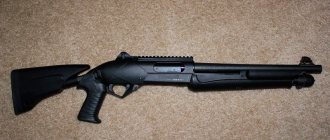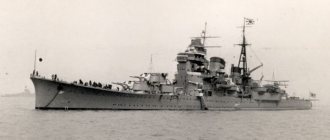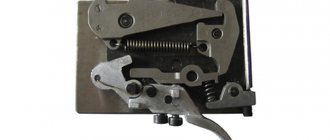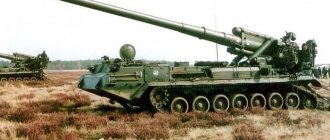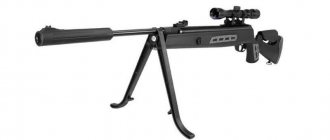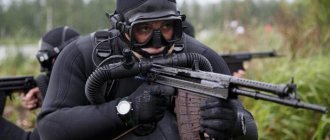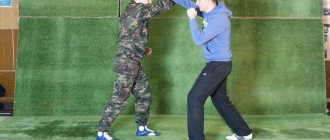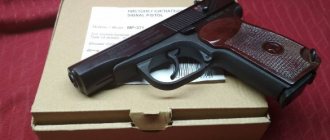We owe the development of a series of revolver-type combat shotguns to Hilton Walker, a native of Rhodesia, South Africa. A talented engineer in the 80s of the last century decided to develop a shotgun that would have an increased capacity magazine for use in an urban environment. Development was completed in South Africa and the first copies were made available to the military for testing and refinement.
The Striker smoothbore combat shotgun was intended for police and military personnel who required high firepower at short distances. The shotgun had a 12-round magazine, which was approximately twice as much as standard shotguns of the time, and an increased rate of fire.
The resulting product interested many people, so the Striker smoothbore revolving shotgun quickly gained popularity among both the military and the civilian population. The Striker shotgun was equipped with special police units.
Subsequently, with the advent of an improved version of the Striker, the Protecta model, which had less weight and was more convenient to handle, the popularity of shotguns of this type increased even more. The Striker shotgun was just the first sign.
Protecta shotguns began to be produced in South Africa by Reutech Defense Industries, and were used both in South Africa itself and sold for export.
Media fame
The original appearance of the Striker, Streetsweeper, and Protecta combat shotguns did not go unnoticed by filmmakers. Guns regularly appeared in the frames of a variety of films, they can be seen in RoboCop, Patriot Games, The Punisher, Stargate, Godzilla, Desperado, and even the domestic D-Day and National Security Agent.
Shotguns are also used in computer games; they can be found in Battlefield 2 and 3, Modern Warfire 3, Resident Evil 4 and 5, Max Payne 2, Stalker: Call of Pripyat.
Description of the Striker shotgun
The original Striker and Protecta shotguns are equipped with short barrels, but for civilian use they are sold with barrels of increased length (more than 500 mm), with two chambers in the drum, tightly sealed with plugs, and a special hook that blocks shooting when the butt is folded.
The Striker smoothbore shotgun is built according to a revolving design, with a self-cocking trigger mechanism and power from a rotating integral drum for 12 rounds (the drum is separated only when disassembling the weapon). When assembled, the drum is hidden inside a non-rotating aluminum casing with openings for loading.
To protect the shooter's hands from burns, the barrel of the weapon is sheathed in a perforated casing with holes for cooling the barrel. The pistol grip together with the trigger mechanism body are a single unit and are made of high-strength polymer. Behind the trigger there is a push-button mechanical safety, which is the only guarantee to prevent an accidental shot.
Since the traditional solution for revolvers with the rotation of the drum by the muscular force of the shooter when pressing the trigger would lead to exorbitant efforts on the trigger for a drum of this size and weight, Walker used a spring mechanism for turning the drum.
After loading the drum with cartridges, the shooter must use the key located at the front end of the drum casing to cock the spiral spring. When you press the trigger, the spring rotates the drum 1/12 of a turn, attaching a new chamber with a cartridge to the barrel.
This scheme ensures a high rate of fire, but it happened that the drum rotated more than one step with one press of the trigger.
The Stryker rifle was reloaded one cartridge at a time through a window in the rear end of the drum casing. Spent cartridges are manually pushed back out of the cylinder using a spring-loaded extractor rod mounted in a casing on the right side of the barrel, and then new cartridges are loaded in their place.
The gun is equipped with a front handle for holding the weapon and an aluminum stock that folds up and down. The barrel is covered with a perforated casing to protect your hands from burns. The body of the trigger mechanism, together with the pistol grip, is made of plastic. The safety is a push-button type, located behind the trigger at the base of the trigger guard and locks the trigger.
Since the shotgun has become widespread not only in its homeland, but throughout the world, it is worth noting that in civilian markets the model is most often sold in a slightly modified version. In the drum, two slots for ammunition are tightly blocked, thus making a 10-round shotgun from a 12-round shotgun. The barrel is lengthened, and the design of the butt is also modernized so that it has a special hook that blocks shooting when folded. The barrels of civilian models are made in length from the minimum established by law - 500 mm.
Based on the Striker, a modification was developed - the Protecta shotgun.
Shotgun Striker
The first prototype of a 12-shot shotgun was called Striker. It was distinguished by a large magazine capacity and a high practical rate of fire. The shotgun market was extremely in demand, so the appearance of the new product caused a real stir.
The weapon was equipped with a front handle for holding the weapon and a cartridge feeding mechanism based on the principle of revolvers. The choice of such a mechanism was based on the need to create a gun that could withstand a high rate of fire with an expanded magazine volume. The drum itself is a round piece that holds 12 rounds of ammunition. Everything is covered from above with a special casing, which ensures the safety of the system. But if it is necessary to repair or disconnect, it is necessary to completely disassemble the structure, which is not always convenient.
The Striker combat rifle meant turning the cylinder during use to ensure the supply of new ammunition. However, it was inappropriate to take as a basis the model of a revolver, in which the mechanism is driven by the physical effort of the shooter. The weight of the feed mechanism in this drum shotgun was too large, and human effort was clearly not enough.
A model of a spring was implemented, which, after equipping the drum, the shooter must wind with a key on its front part. After pressing the trigger, the spring rotates the drum and opens access to the next cartridge. However, since it was quite difficult to calculate the required force of this spring when the shooter presses the trigger, unpleasant consequences arose. Automatic rotation increased the rate of fire, but it happened that the drum turned by a greater degree, missing entire ammunition. This led to the fact that at the end of the shooting, unused cartridges remained among the empty cartridges. But it still had to be reloaded.
As for the extraction of spent cartridges, in this shotgun it was carried out using a special spring-loaded rod. The spent cartridges are manually pushed back, and fresh ammunition is inserted in their place, one cartridge at a time, through a window in the end of the drum.
The shotgun was equipped with a folding stock; note that folding occurs in the “forward and upward” direction.
Since the shotgun has become widespread not only in its homeland, but throughout the world, it is worth noting that in civilian markets the model is most often sold in a slightly modified version. In the drum, two slots for ammunition are tightly blocked, thus making a 10-round shotgun from a 12-round shotgun. The barrel is lengthened, and the design of the butt is also modernized so that it has a special hook that blocks shooting when folded. The barrels of civilian models are made in length from the minimum established by law - 500 mm.
Shotgun Striker
Description of the Protecta shotgun
The Protecta shotgun generally borrows the layout from the Striker shotgun, but the spring mechanism for rotating the cylinder is replaced by a manual mechanism driven by a front handle swinging left and right under the barrel. When you turn the handle, it rotates the barrel casing, and that, in turn, with the help of a special pawl, rotates the drum.
The reloading scheme is generally the same, only spent cartridges (except for the last one) are automatically removed from the drum when firing backwards using powder gases vented from the barrel. The last cartridge case or unused cartridges are removed using a manual extractor rod on the barrel. In addition, holes were made in the rear cover of the drum to allow for monitoring the availability of ammunition. The rest of the Protecta shotgun is similar to the Striker shotgun.
The main advantages of the Striker and Protecta shotguns are their large magazine capacity and practical rate of fire, but the price for this is the large dimensions of the weapon, impressive weight and slow reloading of the magazine after all the cartridges are used up.
Shotgun Protecta
A worthy modification of this weapon was the Protecta gun, which was able to retain all the best from its older brother and bring something new. The design has been modified and improved. Perhaps the main difference between the Protecta and the Stryker is the reloading of the gun. In the protekt, the drum was rotated using a hand lever. Its function was performed by a handle located under the barrel, which moved left and right. The mechanism is driven by connecting the barrel casing to the magazine. Each such movement rotates it 1/12, thus feeding the cartridge. This, of course, did not have the best effect on the rate of fire, but the absence of any slips and other troubles more than compensated for this.
Another pleasant innovation was that in the Protect, spent cartridges flew out of the drum casing on their own under the influence of powder gases. This made the reloading process much easier, despite the fact that the last cartridge still had to be pushed out manually. Everyone agreed that the new way of turning the drum is very convenient.
That's probably all the differences. The same striker entered the market, but much prettier.
Description of the Streetsweeper shotgun
The demand for Protecta shotguns from South Africa on the arms market prompted leading US manufacturers to release their analogue - the Streetsweeper. There are no differences here, however, this model has always been equipped with an elongated barrel, as well as a modernized butt. When the weapon is folded, a special mechanism prohibits firing. There is a special hook in the butt that does not allow a shot after the trigger is pulled.
Shotgun Striker / Streetsweeper / Protecta
| Striker original version |
The Striker smoothbore combat shotgun was developed by Rhodesian Hilton Walker in the early 1980s.
Striker with an 18-inch barrel
After the fall of Rhodesia, Walker moved to South Africa, where he continued his work on weapons. The first examples of a combat shotgun of its design were produced in the mid-1980s in South Africa, and were intended for police and military operations that required large firepower at short firing ranges.
The weapon of Walker's design was distinguished by a large magazine capacity (12 rounds - on average 2 times more than traditional shotguns), as well as a high practical rate of fire. On the other hand, the drum magazine had a large dead weight, was inconvenient to handle, and the weapon mechanism had a number of shortcomings, so in the late 1980s Walker improved his design, calling the new gun Protecta.
Protecta shotguns began to be produced in South Africa by Reutech Defense Industries, and were used both in South Africa itself and sold for export.
Striker with a barrel length of 12 and 9 inches and with a dismounted barrel
The original Striker and Protecta shotguns are equipped with short barrels, but for civilian use they are sold with barrels of increased length (more than 500 mm.), with two chambers in the drum, tightly sealed with plugs, and a special a hook that blocks shooting when the butt is folded.
The Striker smoothbore shotgun is built according to a revolving design, with a self-cocking trigger mechanism and power from a rotating integral drum for 12 rounds (the drum is separated only when disassembling the weapon).
When assembled, the drum is hidden inside a non-rotating aluminum casing with openings for loading. Since the traditional solution for revolvers with the rotation of the drum by the muscular force of the shooter when pressing the trigger would lead to exorbitant efforts on the trigger for a drum of this size and weight, Walker used a spring mechanism for turning the drum. After loading the drum with cartridges, the shooter must use the key located at the front end of the drum casing to cock the spiral spring. When you press the trigger, the spring rotates the drum 1/12 of a turn, attaching a new chamber with a cartridge to the barrel. This scheme ensures a high rate of fire, but it happened that the drum rotated more than 1 step with one press of the trigger. Streetsweeper, an American copy of the Striker shotgun, has an elongated barrel in accordance with US gun laws.
The shotgun was reloaded one cartridge at a time through a window in the rear end of the cylinder casing. Spent cartridges are manually pushed back out of the cylinder using a spring-loaded extractor rod mounted in a casing on the right side of the barrel, and then new cartridges are loaded in their place.
The gun is equipped with a front handle for holding the weapon and an aluminum stock that folds up and down. The barrel is covered with a perforated casing to protect your hands from burns. The body of the trigger mechanism, together with the pistol grip, is made of plastic. The safety is a push-button type, located behind the trigger at the base of the trigger guard and locks the trigger.
| Protecta there is no winding key on the drum; on the right side of the barrel casing there is a manual extractor for removing spent cartridges |
Also based on the Striker, a modification was developed - the Protecta shotgun.
Protecta with folded stock
The Protecta shotgun generally borrows the layout from the Striker shotgun, but the spring mechanism for rotating the cylinder is replaced by a manual mechanism driven by a front handle swinging left and right under the barrel. When you turn the handle, it rotates the barrel casing, and that, in turn, with the help of a special pawl, rotates the drum. The reloading scheme is generally the same, only spent cartridges (except for the last one) are automatically removed from the drum when firing backwards using powder gases vented from the barrel. The last cartridge case or unused cartridges are removed using a manual extractor rod on the barrel. In addition, holes were made in the rear cover of the drum to allow for monitoring the availability of ammunition. The rest of the Protecta shotgun is similar to the Striker shotgun.
The main advantages of the Striker and Protecta shotguns are their large magazine capacity and practical rate of fire, but the price for this is the large dimensions of the weapon, impressive weight and slow reloading of the magazine after all the cartridges are used up.
| Striker | Protecta | |
| Caliber, mm | 12 | |
| Length (stock folded/unfolded), mm | 508 / 792 (304 mm barrel) | 500 / 800 (barrel 304 mm) |
| Barrel length, mm | 304, 457 | |
| Weight without cartridges, kg | 4.2 | 4.2 |
| Drum capacity, no. cartridges | 12 | |
| Chamber, mm | 70 | |
Technical characteristics of combat shotguns
The technical characteristics of the Stryker and Protect shotguns are almost the same. Both guns are also sometimes available with extended barrels and special stocks.
- Country: South Africa.
- Caliber – 12/70 mm.
- Weight – 4.2 kg.
- Barrel length – 304/457 mm (can be extended).
- Magazine capacity – 12 rounds.
- The length of the shotgun with the butt folded or unfolded is 508/792 mm.
| Striker | Protecta | |
| Caliber, mm | 12 | |
| Length (stock folded/unfolded), mm | 508 / 792 (304 mm barrel) | 500 / 800 (barrel 304 mm) |
| Barrel length, mm | 304, 457 | |
| Weight without cartridges, kg | 4,2 | |
| Drum capacity, no. cartridges | 12 | |
| Chamber, mm | 70 | |
Specifications
The technical characteristics of the Stryker and Protect shotguns are almost the same. Both guns are also sometimes available with extended barrels and special stocks.
- Country – South Africa
- Caliber – 12(70mm)
- Weight – 4.2 kg
- Barrel length – 304/457 mm (can be extended)
- Magazine capacity – 12 rounds
- Length of the shotgun with the stock folded or unfolded – 508/792 mm
Stryker shotgun modifications
Advantages and disadvantages
Since the Protecta was produced as a weapon that differs from other shotguns in having an increased magazine capacity, this is its main advantage. In all the time that has passed, they have not been able to create any serious competitor to Protecte.
Another advantage is considered to be the rate of fire. The specific type of cartridge feeding, although considered somewhat outdated and cumbersome, remains one of the fastest. Especially for large bore shotguns.
Advantages of combat shotguns:
- magazine capacity;
- rate of fire;
- reliability.
Of course, it was not without its drawbacks. Stryker and Protecta turned out to be very heavy and bulky even for this type of weapon. This made them much more difficult to use. Another disadvantage of the Protecta is considered to be a very long reload, which is simply impossible to quickly carry out in real combat conditions.
Disadvantages of shotguns:
- big sizes;
- heavy weight;
- difficulty recharging.
The appearance of Stryker and Protecta shotguns had a significant impact on the development of weapons manufacturing. Few people had previously decided to increase the magazine capacity of shotguns. Undoubtedly, this gun found its admirers, despite its shortcomings. To this day, there is a demand for these shotguns, which attract not only functionality, but also a very impressive appearance, which is why they are still produced.
Shotgun Protecta. Why is this gun called the “African revolver monster”?
The gun was designed specifically for combat in dense urban areas by a resident of Rhodesia (now the country is called Zimbabwe) Hilton Walker. The reason for the creation of such an unusual design was the following problem: a standard army shotgun could hold only 7 rounds. This limitation was eliminated head-on in another South African gun, the NeoStead 2000: another magazine was added, which somewhat complicated the design of the weapon.
But Walker solved the problem in a very original way. It is based on the operating principle of a revolver: a cylindrical drum with cartridges. However, very great technical difficulties arose. In the pistol version of the revolver, the drum rotates when the trigger is pressed with the muscular force of a finger. Well, how much does a drum with six revolver cartridges weigh and how much does a drum with a dozen 12-gauge rifle cartridges weigh? It is simply impossible for an ordinary person to turn such a drum with his finger. Although, for example, this is what happens in the Russian MTs-255 revolver gun. But there are only five rounds!
At first, Walker's gun was called the Striker and the cylinder was rotated by a cocked spring. A scheme tested on the legendary PPSh submachine gun. After loading the magazine, a special key was used to cock the spring, designed for two rotations of the drum. However, this design gave rise to a number of other problems, primarily the insufficient rotation of a fully loaded magazine due to simple forgetting. In battle you simply forget to start the gun with the key!
The solution, as always, turned out to be simple to the point of genius. If a person holds a pistol with one hand, then the gun is always held with two, otherwise, due to the strong recoil when fired, it will simply fly out of the hands. The handle for the second hand began to move the drum scrolling mechanism to a certain angle. The side effects of eliminating the spring were a sharp increase in reliability and a non-critical decrease in the rate of fire.
The design is divided into two sections: the trigger mechanism and the drum rotation mechanism. The stock is folding. To protect the shooter’s hands during intense shooting, the barrel is covered with a casing, which also serves as a rotator for the cartridge drum and a muzzle brake-compensator. The drum rotates in an aluminum cylindrical casing with a reloading hole. This casing comes off when cleaning. The sights are primitive and located on the receiver. The spent cartridges are knocked out by an extractor rod attached to the barrel.
So, the shooting process. You remove the weapon from the safety, which is located in front of the trigger. You press the trigger with your index finger. Shot. With your other hand, you sharply pull the hold handle left and right, turning the drum. Press the trigger again.
The mechanism for extracting spent cartridges is made in an original way. There is a gap between the drum and the barrel cut, where some of the gases escape when fired. And the spent cartridge case is just opposite the charging hole. So the powder gases seem to blow the spent cartridge case out of the drum, and it flies out automatically. Only the last spent cartridge remains in the drum.
The gun is loaded in the same way as the most primitive revolvers, somewhat reminiscent of a Nagant or, rather, the legendary Colt SAA. First you knock out the last remaining cartridge case, the rest of the chambers are empty. You insert the cartridge into the chamber socket. You turn it around. You insert the cartridge into the chamber again. And so on until the entire drum is filled with cartridges.
Specifications:
Caliber: 12 smoothbore. Length: full - 800 mm, folded - 500 mm. Barrel length: 457 mm. The modification with a 304 mm barrel is not supplied to the civilian market. Weight: 4.2 kg. Materials: gun steel, gun plastic, aluminum alloy stock.
Advantages:
Unusual, terrifying appearance. You will never get confused!
According to reviews from gun forums, the gun accurately shoots bullets, buckshot and shot.
The reliability of the “revolving circuit” is unusually high. There is nothing to break.
With the stock folded, the weapon is quite compact.
The barrel is covered with a casing.
You hardly feel any recoil: the heavy weight and the muzzle brake-compensator do their job.
Flaws:
Heavy weight.
Long reload time.
It is inconvenient to shoot offhand. However, it is not intended for this.
The functional purpose of this weapon is combat operations at close distances, up to 30 m.
Long trigger pull: first the hammer is cocked, and only then the shot follows. This should not have the best effect on accuracy. Although... It's a matter of habit. If you read reviews from owners on gun forums, they claim that the long stroke does not interfere with accurate shooting.
A tool is required for complete disassembly. Although why disassemble it completely?
Well, Russian capsules are too hard for him. Often they don’t get through. There are no problems with imported cartridges.
A similar “monster” is also supplied to Russia. In order for the weapon to comply with the Russian law “On Weapons”, two chambers are tightly clogged, and a disconnector is placed on the base of the butt - a metal strip that prevents the trigger from hitting the primer if the butt is folded. The barrel length has been increased to 560 mm, which further increases the weight of this “monster”.
The price for this exotic piece of hardware is very high, but there are buyers. And, interestingly, they don’t regret it later.
Tags: history of weapons, shooting, weapons, technology, inventions
